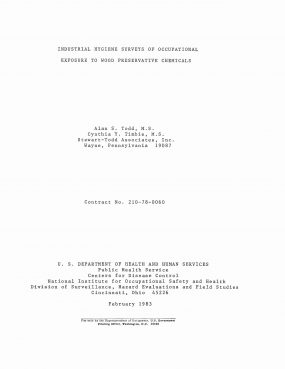Industrial Hygiene Surveys of Occupational Exposures to Wood Preservative Chemicals
February 1983
DHHS (NIOSH) Publication Number 83-106

Industrial hygiene studies were conducted at eleven wood treating plants and two manufacturing operations as part of an industrywide evaluation of worker exposure to wood preservative chemicals. The purpose of these field studies was to evaluate airborne exposure levels and characterize existing work practices and other methods of exposure control. The wood preservative industry is comprised of over 1,000 plants in the United States with the majority employing less than ten workers in wood treatment processing. Approximately 500 plants are members of industrial trade associations: American Wood Preservers Institute (AWPI) and American Wood-Preservers’ Association (AWPA), and others. It is estimated that about ten major plants produce 50% of the total treated wood in the United States. The report presents the findings from preliminary walk-through and in-depth industrial hygiene studies of the various wood preservative processes. In general, employee exposures to preservative chemicals during wood treatment were well below the current applicable occupational standards. Short-term peak exposures occur during critical tasks, such as cylinder opening and unloading, when filling non-pressure tanks with hot PCP oil solutions and during inspection and sampling of treated wood. The exposure levels measured were all well below current guidelines for significant health risk. The personal sampling data generated from the comprehensive study is basically in agreement with exposure findings of past surveys conducted by the wood treatment industry and Health Hazard Evaluations done by NIOSH. The study emphasizes the need for improved work practices to further minimize worker exposure and contact with recognized toxic chemicals during emergency spills, non-routine situations or critical process tasks. Recommendations are given for personal protective equipment, modified work practices, and medical surveillance programs.
Industrial Hygiene Surveys of Occupational Exposures to Wood Preservative Chemicals
